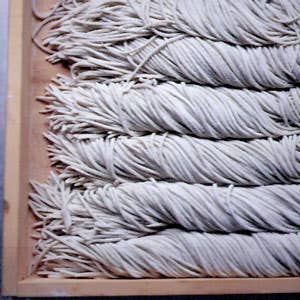
Only one percent of Japanese buckwheat is ground by individual soba makers like Sakamoto, according to Kato Atsushi of the Japan Buckwheat Association—and the skill required to make noodles by hand from just-ground buckwheat flour is such that the best soba is inevitably a luxury food. But mass-produced versions are eagerly devoured all over Japan—on the street, in train stations—for a few dollars a serving.
Buckwheat noodles are sold in Japan in three forms: freshly rolled and cut (kisoba), mostly served in soba specialty shops; dried (hoshisoba or kansoba), sold in supermarkets and specialty shops; and parboiled (yudesoba), sold in supermarkets and served at inexpensive noodle stands. (To further confuse things, the word soba can be applied to noodles with no buckwheat at all, like Chinese-style wheat noodles—chuka soba—and Okinawan-style wheat noodles—okinawa soba.)
No one disputes the superiority of fresh soba over other forms, but dried soba with at least 80 percent buckwheat flour is best for home eating. Parboiled soba contains as much as 95 percent wheat flour, and tends to be soggy, with little buckwheat flavor.
Keep Reading
Continue to Next Story










